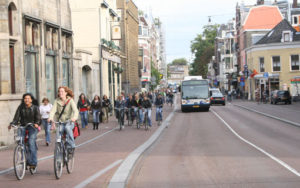Diversity for Efficiency
In the HVAC realm, engineers understand diversity factors. You size the systems understanding that not every space will be requiring full airflow all the time, and you use a factor based on anticipated usage loads that allows a slightly smaller system, helping to achieve greater efficiency in budget as well as in system operations.
This concept should hold true in any work looking for greater sustainability.
For an easy example, I was riding my Segway to work this morning and was immensely grateful they had repaved the road – smooth sailing – on State Street alongside Washington Park in Albany, NY. This had been one of the worst roads to travel by car or by bike/board. As I was enjoying the velvet ride, I realized a car ahead had the driver’s side door fully open, and I had to swerve to avoid becoming one with that new pavement.
At first I was furious at the driver – I mean, he was unloading stuff on the sidewalk side and he still left the door on the street side wide open. I am still angry with him, frankly. That action was inconsiderate and dangerous. Then my brain thought – wow, we need roads wide enough to accommodate bike lanes, clear with ample space for wide open car doors, separate and safe from driving lanes. But then my inner green soul of reason chimed in – NOPE. What this situation needs is a diversity factor so the roads make sense economically and space-wise. We must include in that approach collaboration and driver/bicyclist education for safe “share the roads” strategies. No community can afford to entirely re-do all of their roads for separate bike lanes with lighting and safety walks. We don’t have the space or the money, or the capacity to maintain such extensive infrastructure, and we need, therefore, a diversity factor.
I love that the Netherlands started most city planning after WWII knowing the importance of bikes. Their planning properly accommodated separate bike lanes alongside many roads, but even there many, many roads are multi-modal. They have, on the shared roads, a diversity factor even if they don’t call it that.
The roads are even tight by the standards of most cities in the USA. This works because the drivers and bicyclists have a mutual respect and responsibility and they follow the same understood rules. How can this space be well-used by all without simply adding up the needed widths and coming to a ridiculously wide and often vacant vista of hardscape? The goal is to optimize the investment with the usage patterns, including the concept of community sharing.
Another example of where we need to employ a diversity factor is in the economic spectrum. Here, we talk about diversity most often as (unfortunately) a percentage to achieve in minority and women owned businesses “utilization”. But isn’t the goal to implement a diversity factor in our economic base that creates the ability to optimize response and performance? Perhaps even to ensure resiliency of our economic base? We need many small companies in the construction industry, located all around the state, so that when big jobs come in we can pull many hands to the effort, and when there are smaller jobs we can disperse as needed. And we need diversity in skills as well, including some redundancy and overlap in those skills. The design and construction fields ebb and flow, as do the required skill sets. Let’s look at diversity as an optimization that helps the economy to weather unforeseen changes, and let’s make sure that our diversity planning includes communication and collaboration instead of just meeting seemingly arbitrary percentages. Define the needed value and the usage patterns and engage in the diverse options to meet the challenges. Engage. Communicate. Seek Diversity.
Jodi
Be the first to like this post (no login required)
